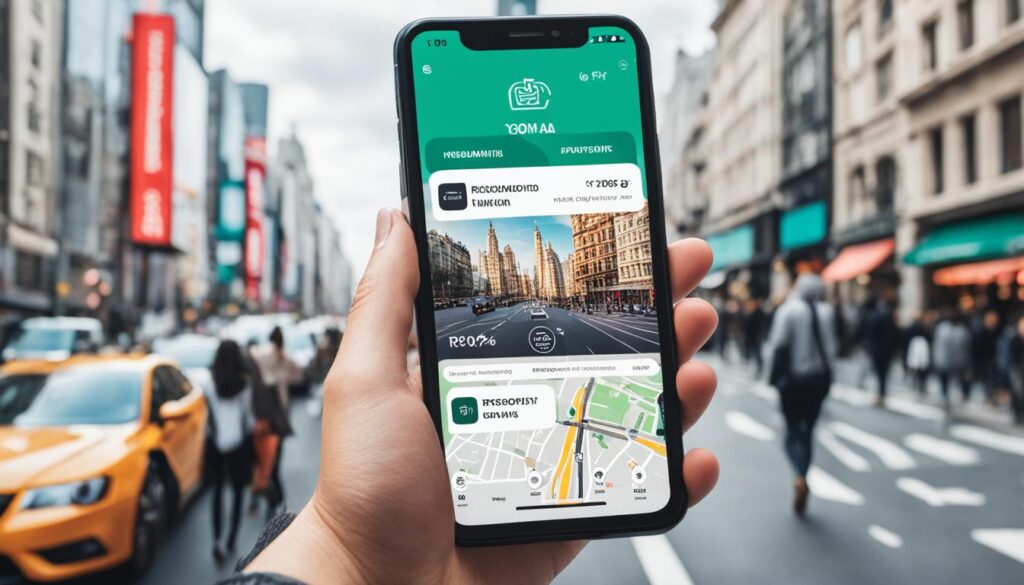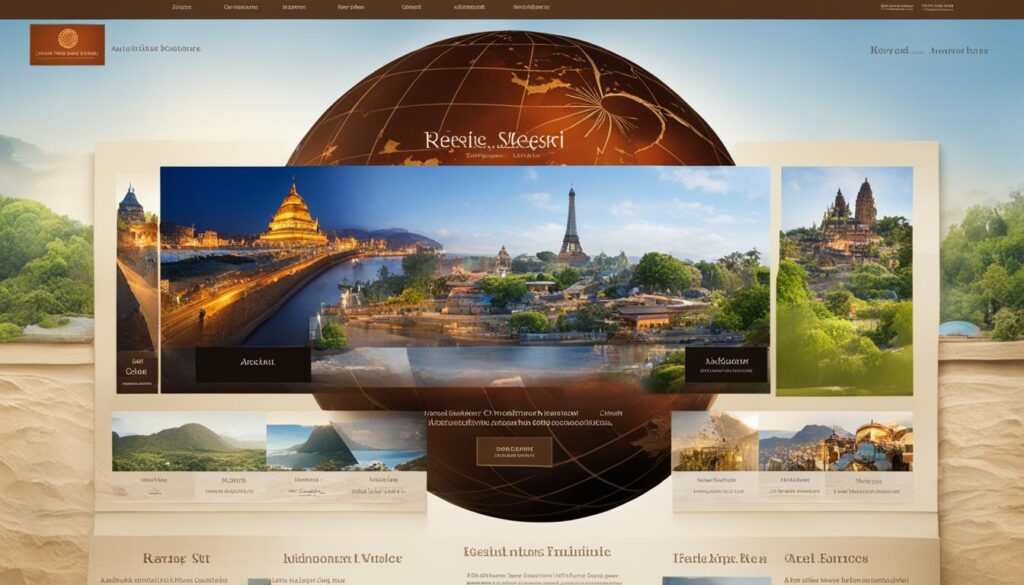Gone are the days of one-size-fits-all marketing campaigns. With the advancements in technology and the abundance of data available, brands can now personalize their outreach and engage with users on a whole new level. One of the most powerful strategies in this realm is location-based personalization, which leverages geolocation data to deliver personalized content and experiences to users based on their location.
Imagine receiving tailored recommendations for nearby restaurants or shops, exclusive offers specific to your city, or personalized messages based on local events and holidays. This is the beauty of location-based personalization, which combines the power of data and relevance to create impactful experiences for users.
Whether it’s through personalized location services, location-based targeting, geolocation marketing, or location-based advertising, brands can tap into the potential of location data optimization to enhance user engagement and drive conversions. Companies like Starbucks, Uber, and Airbnb have successfully implemented location-based personalization to provide seamless and relevant experiences to their users.
Table of Contents
ToggleKey Takeaways:
- Location-based personalization utilizes geolocation data to deliver personalized content and experiences based on user location.
- Technologies like geotargeting, geofencing, beacons, and data enrichment power location-based personalization.
- Benefits include increased user engagement, targeted marketing, and improved conversion rates.
- Implementing location-based personalization requires a comprehensive data collection strategy and audience segmentation.
- Personalization tactics for websites include homepage customization, location-based offers, personalized welcome messages, and customized product pages.
How Location-Based Personalization Works
Location-based personalization relies on several technologies, including geotargeting, geofencing, beacons, and data enrichment. These technologies enable brands to deliver personalized offers, recommendations, and messaging based on the user’s location.
- Geotargeting: With geotargeting, marketers can define a targeted audience based on users’ last-known location. By understanding where users are located, brands can tailor their content and promotions to suit their specific needs and preferences.
- Geofencing: Geofencing allows brands to trigger campaigns when users enter a pre-defined area. This can be used to deliver location-specific offers, promotions, and information to users when they are physically present in a specific location, such as a retail store or event.
- Beacons: Beacons operate within a smaller radius and deploy outreach when individuals are within reach of a physical object. These small devices can send personalized notifications or messages to users’ smartphones when they are in proximity to a beacon, allowing brands to engage with customers in real-time.
- Data Enrichment: Data enrichment involves infusing first-party data with additional information from third-party location services. By enriching user data with contextual information such as local weather, nearby points of interest, or demographic insights, brands can enhance the personalization of their offerings and create more relevant experiences.
By leveraging geotargeting, geofencing, beacons, and data enrichment, brands can create highly targeted and personalized experiences for their users. This can lead to increased engagement, customer satisfaction, and improved conversion rates.
Location-based personalization is revolutionizing the way brands connect with their audience. By harnessing the power of geolocation data and utilizing advanced technologies, brands can deliver tailored experiences that resonate with users on a personal level.
Benefits of Location-Based Personalization
Adopting a location-based personalization strategy offers several benefits for brands. By taking a hyperlocal approach, brands can cater to the specific needs and interests of users in different regions, resulting in increased user engagement. Localized outreach helps brands establish a closer connection with their audience and build hometown pride. Targeted marketing campaigns based on location data can lead to higher conversion rates and improved ROI. Additionally, personalized experiences based on location can enhance the overall user experience and strengthen brand loyalty.
Increased User Engagement
By implementing location-based personalization, brands are able to deliver tailored content and offers to users based on their specific location. This level of personalization creates a more relevant and engaging experience for users, leading to higher levels of engagement with the brand’s website, app, or platform.
Localized Outreach
Location-based personalization allows brands to establish a closer connection with their audience by delivering content and offers that are specific to their local area. This localized outreach helps to build a sense of hometown pride and community, making users feel more connected to the brand.
Targeted Marketing
By leveraging location data, brands can create highly targeted marketing campaigns. This targeted approach ensures that the right message reaches the right audience at the right time, increasing the likelihood of conversions and improving ROI.
Personalized Experiences
Location-based personalization enables brands to create personalized experiences for their users. By understanding a user’s location, brands can deliver tailored recommendations, offers, and content that resonate with their specific needs and interests. This level of personalization enhances the overall user experience and helps to build stronger brand loyalty.
| Benefits of Location-Based Personalization | |
|---|---|
| Increased user engagement | By delivering tailored content based on location, user engagement levels can significantly increase. |
| Localized outreach | Building a closer connection with local audiences by delivering content tailored to their area. |
| Targeted marketing | Utilizing location data to create highly targeted marketing campaigns, resulting in better conversions and ROI. |
| Personalized experiences | Creating unique and personalized experiences for users based on their location, leading to stronger brand loyalty. |
Implementing Location-Based Personalization
Implementing location-based personalization requires a well-defined data collection strategy to ensure compliance with privacy regulations and build trust with users. Brands need to obtain permission to track users’ locations while prioritizing their privacy. By leveraging best practices and integrating location-based technologies, brands can achieve effective personalization and enhance the overall user experience.
“Obtaining permission to track users’ locations is crucial for implementing location-based personalization. This includes transparently communicating the purpose of data collection and giving users control over their privacy settings.”
Developing a Data Collection Strategy
When implementing location-based personalization, brands should establish a comprehensive data collection strategy that focuses on obtaining permission-based tracking. This involves:
- Clearly communicating the purpose of data collection and how it benefits the user.
- Providing users with easy-to-understand privacy settings and options to control location tracking.
- Ensuring compliance with privacy regulations, such as obtaining consent as required by laws like the General Data Protection Regulation (GDPR) and the California Consumer Privacy Act (CCPA).
- Regularly reviewing and updating privacy policies to maintain transparency and accountability.
By implementing a robust data collection strategy, brands can earn the trust of their users and lay the groundwork for effective location-based personalization.
Implementing Best Practices
Effective location-based personalization relies on implementing best practices that maximize the value of collected data. Some key best practices include:
- Leveraging first-party data: Utilizing data directly collected from your own audience helps ensure accuracy and relevance.
- Utilizing third-party location services: Enriching first-party data with additional information from reputable third-party providers can enhance personalization efforts.
- Integrating location-based technologies: Integrating geotargeting, geofencing, or beacon technologies into existing marketing platforms enables seamless and efficient deployment of personalized experiences.
- Considering language-based personalization: For brands targeting international audiences, adapting content and messaging to local languages and cultural nuances enhances personalization and engagement.
By following these best practices, brands can optimize the implementation of location-based personalization and deliver highly targeted and relevant experiences to their audience.
Best Practices for Implementing Location-Based Personalization
| Best Practices | Description |
|---|---|
| Leverage First-Party Data | Utilize data collected directly from your audience to ensure accuracy and relevance. |
| Utilize Third-Party Location Services | Enhance personalization efforts by enriching first-party data with reliable third-party location information. |
| Integrate Location-Based Technologies | Integrate geotargeting, geofencing, or beacon technologies into existing platforms for seamless deployment of personalized experiences. |
| Consider Language-Based Personalization | Adapt content and messaging to local languages and cultural nuances for effective personalization of international audiences. |

Implementing location-based personalization requires careful consideration of data collection, permission-based tracking, and following best practices. By prioritizing privacy, leveraging data effectively, and integrating location-based technologies, brands can achieve effective personalization and deliver highly targeted experiences that enhance user engagement and drive business growth.
Geographic Personalization on Websites
Geographic personalization on websites is a powerful strategy that involves tailoring content, offers, and products to website visitors based on their geographic location. By using market segmentation, specifically geographic segmentation, brands can create location-specific audiences and deliver personalized experiences to users.
Implementing geographic personalization allows brands to provide a more targeted and relevant browsing experience for their website visitors. This level of personalization enhances user engagement and increases the likelihood of conversions.
Examples of geographic personalization on websites include:
- Displaying location-specific banners: Brands can showcase banners that are specific to a visitor’s location, creating a sense of relevance and familiarity.
- Offering location-based discounts: By providing discounts or promotional offers based on a user’s geographic location, brands can incentivize conversions and drive sales in specific regions.
- Adjusting messaging to include location-specific language nuances: Brands can create messaging that speaks to the unique cultural and linguistic aspects of different regions, making the content more relatable and resonant with the audience.
By strategically implementing geographic personalization on websites, brands can improve conversions, increase customer satisfaction, and strengthen their overall online presence.

| Benefits of Geographic Personalization on Websites | Implementation Strategies |
|---|---|
|
|
Geographic personalization on websites offers numerous benefits for brands, ranging from improved user experience and higher conversion rates to increased customer engagement and enhanced brand loyalty. By tailoring content, offers, and products to the specific needs and interests of users in different geographic locations, brands can create a more personalized and resonant browsing experience. This, in turn, leads to better conversions and overall business growth.
Creating a Personalization Strategy
When implementing a personalization strategy, it is essential for brands to have clear goals in mind. By defining objectives, brands can focus on tailoring specific elements of their website to deliver personalized experiences. These goals can range from increasing conversions to enhancing customer satisfaction.
Data collection forms the foundation of a successful personalization strategy. Visitor profiling allows brands to gain insights into users’ demographics, behaviors, and interests. By understanding their audience, brands can create more targeted and effective personalized experiences. This information can be obtained through various methods, such as website analytics, surveys, and user registration forms.
Audience segmentation plays a crucial role in personalization strategies. By categorizing users based on their geographic location, brands can identify preferences specific to different regions. This allows for the customization of content and experiences that resonate with local audiences. In addition to location, factors such as time zone, season, and weather can further enhance the personalization of the customer experience.
To visually represent the components of a personalization strategy, the table below outlines the key steps involved:
| Step | Description |
|---|---|
| 1 | Set Clear Goals |
| 2 | Collect Relevant Data |
| 3 | Profile Visitors |
| 4 | Segment Audience by Location |
| 5 | Consider Other Variables |
By following these steps, brands can create a robust personalization strategy that drives engagement, conversions, and customer satisfaction.
Personalization Tactics for Websites
Implementing location-based personalization on websites requires the use of effective tactics to create a tailored and compelling browsing experience. Here are some tactics that brands can employ:
Homepage Customization
Customizing the homepage based on location-specific insights can significantly enhance user engagement. This can be achieved by adjusting the messaging, design, and pop-ups to cater to the interests and preferences of visitors from different locations.
Location-Based Offers
Offering location-based discounts and promotions can be an effective way to entice customers from specific areas. By personalizing the offers based on the customers’ geolocation, brands can increase the likelihood of conversion and encourage repeat visits.
Personalized Welcome Messages
A personalized welcome message that acknowledges the customer’s location can create a warm and tailored experience. Whether it’s greeting them with a “Welcome to our [city/region] store” or offering location-specific recommendations, personalized welcome messages help customers feel valued and engaged.
Location-Specific Landing Pages
Creating location-specific landing pages allows brands to provide visitors with a more targeted browsing experience. By tailoring the content and offers on these pages to match the interests and needs of visitors from different locations, brands can increase the chances of conversion.
Category Recommendations
Customizing category pages based on location-specific interests can help visitors discover relevant products and services more easily. By analyzing the preferences and browsing behavior of users from different locations, brands can present personalized category recommendations that enhance the overall user experience.
Customized Product Pages
Customizing product pages based on location can provide users with valuable information that influences purchasing decisions. Incorporating testimonials and reviews from customers in the same location, displaying relevant shipping information, and suggesting related products based on local preferences can all contribute to a more personalized and engaging product page.

| Tactic | Description |
|---|---|
| Homepage Customization | Adjust messaging, design, and pop-ups based on location-specific insights. |
| Location-Based Offers | Provide discounts and promotions tailored to customers’ geolocation. |
| Personalized Welcome Messages | Greet customers with location-specific messages to create a personalized experience. |
| Location-Specific Landing Pages | Create targeted landing pages based on the visitor’s location. |
| Category Recommendations | Customize category pages to match location-specific interests. |
| Customized Product Pages | Optimize product pages with testimonials, shipping information, and related products personalized to the user’s location. |
Impact of Geographic Personalization on Conversions
Geographic personalization has a significant impact on conversions. Studies have shown that personalized content can double the conversion rate compared to non-personalized content. By delivering location-specific messages, offers, and recommendations, brands can create a more meaningful and relevant customer experience, leading to higher engagement and improved conversion rates.
Even small increases in on-page conversions can result in significant revenue growth. Investing in geographic personalization can help brands develop a trusting relationship with their customers and drive repeat business. When customers feel that the brand understands their specific location and needs, they are more likely to make a purchase and become loyal customers.
Benefits of Georaphic Personalization:
- Increased conversion rates
- Revenue growth
- Improved customer experience
“Personalized marketing campaigns result in a higher number of conversions and significant revenue growth.”
Let’s consider the following scenario:
| Non-Personalized Marketing | Geographic Personalization |
|---|---|
| Conversion Rate: 2% | Conversion Rate: 4% |
| Monthly Traffic: 5000 | Monthly Traffic: 5000 |
| Conversions per Month: 100 | Conversions per Month: 200 |
| Average Order Value: $50 | Average Order Value: $50 |
| Monthly Revenue: $5,000 | Monthly Revenue: $10,000 |
In this example, implementing geographic personalization doubles the conversion rate from 2% to 4%. With the same amount of monthly traffic, the number of conversions per month increases from 100 to 200, resulting in monthly revenue growth from $5,000 to $10,000. This demonstrates the significant impact that geographic personalization can have on a brand’s bottom line.
To achieve these results, brands must focus on delivering relevant and location-specific content and offers to their customers. By leveraging location data and implementing effective personalization strategies, brands can enjoy increased conversion rates, revenue growth, and an improved customer experience.
Investing in geographic personalization is an opportunity for brands to deliver more impactful marketing campaigns and provide a tailored experience that resonates with their target audience, ultimately driving conversions and revenue growth.

By analyzing customer behavior and responding with location-specific marketing tactics, brands can optimize their conversions and revenue streams, while simultaneously creating a more personalized and enjoyable experience for customers.
Conclusion
Location-based personalization offers numerous benefits for brands, allowing them to enhance user engagement, implement targeted marketing strategies, and increase conversions. By leveraging geolocation data, brands can customize their content and experiences to meet the specific preferences and needs of users in different locations, resulting in a superior user experience and greater brand loyalty.
To successfully implement location-based personalization, brands should focus on three key areas: data collection, audience segmentation, and personalization tactics for websites. Collecting accurate and permission-based location data is essential for compliance with privacy regulations and establishing trust with users. By segmenting the audience based on geographic location, brands can gain valuable insights into location-specific preferences and tailor their marketing strategies accordingly.
To further optimize the user experience, brands can employ various personalization tactics on their websites. Customized homepage content, location-based offers, personalized welcome messages, and adjusted landing pages can all contribute to increasing conversion rates and improving user satisfaction. Investing in geographic personalization can lead to substantial revenue growth as even small improvements in conversion rates can have a significant impact.
Implementing location-based personalization requires ongoing learning and experimentation. By continuously testing and refining their strategies, brands can deliver meaningful and impactful experiences to their customers, fostering stronger connections and driving business success. Location-based personalization is a powerful tool that enables brands to stand out in a crowded marketplace, deliver targeted messaging, and provide tailored experiences that resonate with users on a personal level.
FAQ
What is location-based personalization?
Location-based personalization is a marketing strategy that utilizes geolocation data to deliver personalized content and experiences to users based on their location. By leveraging technologies like geotargeting, geofencing, beacons, and data enrichment, brands can tailor their outreach and marketing campaigns to specific regions, countries, or even neighborhoods.
How does location-based personalization work?
Location-based personalization is powered by various technologies such as geotargeting, geofencing, beacons, and data enrichment. Geotargeting allows marketers to define a targeted audience based on users’ last-known location. Geofencing triggers campaigns when users enter a pre-defined area. Beacons operate within a smaller radius and deploy outreach when individuals are within reach of a physical object. Data enrichment involves infusing first-party data with additional information from third-party location services.
What are the benefits of location-based personalization?
Adopting a location-based personalization strategy offers several benefits for brands. By taking a hyperlocal approach, brands can cater to the specific needs and interests of users in different regions, resulting in increased user engagement. Localized outreach helps brands establish a closer connection with their audience and build hometown pride. Targeted marketing campaigns based on location data can lead to higher conversion rates and improved ROI. Additionally, personalized experiences based on location can enhance the overall user experience and strengthen brand loyalty.
How can I implement location-based personalization?
Before implementing location-based personalization, brands need to develop a comprehensive data collection strategy that includes obtaining permission to track users’ locations. This ensures compliance with privacy regulations and builds trust with users. Best practices for effective personalization include leveraging first-party data, utilizing third-party location services, and integrating location-based technologies into existing marketing platforms. Brands should also consider language-based personalization for international audiences to effectively execute global and local marketing strategies.
What is geographic personalization on websites?
Geographic personalization on websites involves tailoring content, offers, and products to website visitors based on their geographic location. This strategy uses market segmentation, specifically geographic segmentation, to group visitors into location-specific audiences. By personalizing website content, brands can provide a more targeted and relevant browsing experience, leading to improved conversions.
How can I create a personalization strategy?
To create an effective personalization strategy, brands need to set goals and determine which elements of their website they want to personalize. Data collection plays a crucial role in this process, including visitor profiling to understand users’ demographics, behaviors, and interests. Audience segmentation based on geographic location helps identify location-specific preferences and informs personalization strategies. Brands should also consider other variables like time zone, season, and weather to further personalize the customer experience.
What are some personalization tactics for websites?
There are various tactics that brands can employ to personalize websites for location-based personalization. These include customizing the homepage by adjusting messaging, design, and pop-ups based on location-specific insights. Offering location-based discounts and promotions can entice customers from specific areas. Personalized welcome messages can make the customer feel acknowledged and catered to. Location-specific landing pages can provide a more targeted browsing experience, and category pages can be customized based on location-specific interests. Lastly, customizing product pages with testimonials, shipping information, and product recommendations based on location can further enhance the personalized experience.
What is the impact of geographic personalization on conversions?
Geographic personalization has a significant impact on conversions. Studies have shown that personalized content can double the conversion rate compared to non-personalized content. By delivering location-specific messages, offers, and recommendations, brands can create a more meaningful and relevant customer experience, leading to higher engagement and improved conversion rates. Even small increases in on-page conversions can result in significant revenue growth. Investing in geographic personalization can help brands develop a trusting relationship with their customers and drive repeat business.
What are the benefits of location-based personalization?
Location-based personalization offers a range of benefits for brands, including increased user engagement, targeted marketing, and improved conversions. By implementing a personalized strategy based on geolocation data, brands can tailor their content and experiences to the specific needs and interests of users in different locations. This improves the overall user experience, strengthens brand loyalty, and drives revenue growth. To successfully implement location-based personalization, brands should focus on data collection, audience segmentation, and personalization tactics for websites. By continuously learning and experimenting, brands can create meaningful and impactful experiences for their customers.











